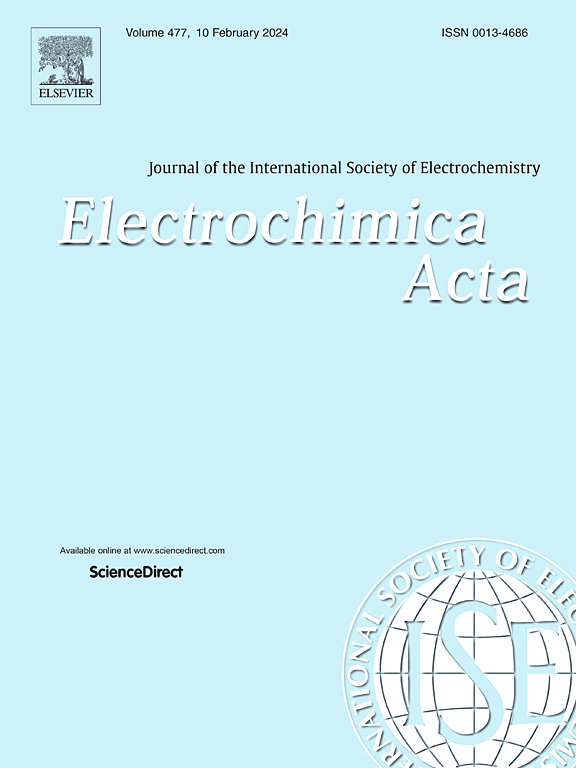Design and optimization of the “TiO2-Al” interfacial layer in B4C/Al composites by adding TiO2 nanoparticles to improve their electrochemical corrosion resistance
IF 5.6
3区 材料科学
Q1 ELECTROCHEMISTRY
引用次数: 0
Abstract
In most aluminum matrix composites, the galvanic effects at the reinforcement/matrix interface aggravate local corrosion, thereby limiting their application in various environments. This paper presents a method to reduce the driving force of electrochemical (micro-galvanic) corrosion by introducing an interfacial layer composed of nanoparticles. In general, this layer enhanced the corrosion resistance by improving the interfacial bonding and inhibiting the formation of interfacial reaction products. Moreover, the TiO2 nanoparticles and the Al matrix had similar electron work functions; hence, no additional electrochemical corrosion occurred between them. The influence of TiO2 content (0.0, 1.0, 2.0, and 2.5 vol.%) on the corrosion resistance of B4C/Al composite was investigated in a corrosive Cl− ion environment. The corrosion resistance was affected by changes in the “TiO2-Al” interfacial layer and the grain size of the Al matrix caused by variations in the TiO2 content. According to the potentiodynamic polarization analysis, the TiO2@B4C/Al composite with 2.0 vol.% TiO2 nanoparticle content demonstrated the best corrosion resistance because of the dense passive film on its surface, which weakened the micro-galvanic corrosion. The thick, dense passive film acted as a barrier and prevented interactions between corrosive Cl− ions and the composite. Moreover, the “TiO2-Al” interfacial layer relieved the residual stress, consequently decreasing the Volta potential difference between the reinforcement and the Al matrix, which drives micro-galvanic corrosion. Owing to its excellent corrosion resistance, the B4C/Al composite demonstrates broad prospects in marine and neutron shielding applications.通过添加TiO2纳米粒子,设计优化B4C/Al复合材料中“TiO2-Al”界面层,提高其电化学耐腐蚀性
在大多数铝基复合材料中,增强体/基体界面处的电偶效应加剧了局部腐蚀,从而限制了其在各种环境中的应用。本文提出了一种通过引入纳米颗粒组成的界面层来降低电化学(微电)腐蚀驱动力的方法。总的来说,该层通过改善界面结合和抑制界面反应产物的形成来增强耐蚀性。此外,TiO2纳米粒子与Al基体具有相似的电子功函数;因此,它们之间没有发生额外的电化学腐蚀。在Cl -离子腐蚀环境中,研究了TiO2含量(0.0、1.0、2.0和2.5 vol.%)对B4C/Al复合材料耐蚀性的影响。TiO2含量变化引起的“TiO2-Al”界面层和Al基体晶粒尺寸的变化影响了材料的耐蚀性。根据动电位极化分析,TiO2纳米颗粒含量为2.0 vol.%的TiO2@B4C/Al复合材料由于其表面有致密的钝化膜,从而减弱了微电腐蚀,具有最佳的耐蚀性。厚而致密的钝化膜起到屏障的作用,阻止了腐蚀性Cl−离子与复合材料之间的相互作用。此外,“TiO2-Al”界面层减轻了残余应力,从而减小了增强体与Al基体之间的伏特电位差,从而驱动微电偶腐蚀。由于B4C/Al复合材料具有优异的耐腐蚀性,在船舶和中子屏蔽方面具有广阔的应用前景。
本文章由计算机程序翻译,如有差异,请以英文原文为准。
求助全文
约1分钟内获得全文
求助全文
来源期刊

Electrochimica Acta
工程技术-电化学
CiteScore
11.30
自引率
6.10%
发文量
1634
审稿时长
41 days
期刊介绍:
Electrochimica Acta is an international journal. It is intended for the publication of both original work and reviews in the field of electrochemistry. Electrochemistry should be interpreted to mean any of the research fields covered by the Divisions of the International Society of Electrochemistry listed below, as well as emerging scientific domains covered by ISE New Topics Committee.
 求助内容:
求助内容: 应助结果提醒方式:
应助结果提醒方式:


